installation

Stone Web – Expanding Space
Idalene Rapp (DE), Natascha Unger (DE)
In Stone Web, Basalt is transformed into a light, stable modular system that can be used for small scale applications such as furnishing or combined to create large, spatial structures or urban furniture. Due to its scalability and production optimization, for example using robotics, future applicability ranges from landscape design to architecture. *Stone Web*, seen equally as an art object and product, finds its place between space, urban object, furniture, architecture, boundary, and installation.
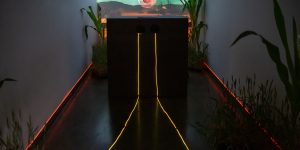
Navigating without a View
Maria Dada (UK), Yuan Yu Chen Feng (VE), Maria Bika (EL), Costas Kazantzis (EL), Greta Gandossi (IT), Ragnar Hrafnkelsson (IS), Fergus O’Connor (UK)
Navigating without a View is an immersive installation that investigates the possibilities of orientation in a world without a map or a compass, a world without representation and established views or truths. When guidance and direction become impossible everything falls back on the senses. But what becomes of the senses when they are altered by the digital, quantitative and mathematical?
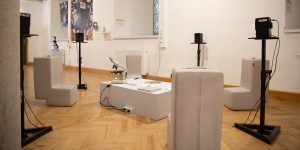
TARDIGRADA – von mikrobiotischen Lebenskünstlern
Maria Antonia Schmidt (DE)
The tardigrade or water bear, a microorganism, survives environmental conditions that hardly any other living creature can withstand. While researchers are working on deciphering the secrets of the tardigrade's survival, the media are throwing themselves at the cute bear and marketing it in all conceivable variations. In the end, the work poses the question of what sound these tiny creatures make. This is reason enough for the world's first tardigrade nano-ear experiment: a musical radio feature/4channel audio installation between science and absurdity.
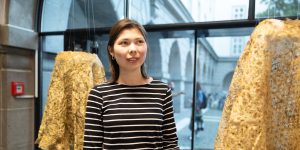
Rhizomes
Freya Probst (DE/UK)
These grown gowns are the outcome of a series of experiments and playful interactions with plants and the observation of their roots through photography or time-lapse video. Experiments with pearls, small gears, or the positioning of seeds lead to different plant responses. The outcome was eventually applied to larger surface areas in the shape of cutting patterns reminiscent of fine woven textiles. The exhibits show a subterranean, hidden aesthetic of a natural structure that cannot be copied by humans.

Rêverie Reset
Yan Lei (CN)
Rêverie Reset is a system that expands on Yan Lei's practice of dissolving images into concepts. The video-installation makes use of cutting-edge computational systems and networking technologies in order to reaffirm the artist's notion of the artificiality of representation and the irrelevance of the image.
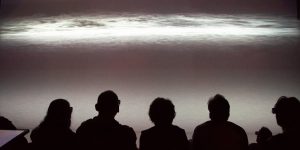
NOLANDX
Ulf Langheinrich (DE)
*NOLANDX* is an audiovisual composition. The aesthetic nucleus of the work are the image planes, algorithmically generated noise and lines as well as recordings of sea waves. This referential source material is transformed by slit-scan and other interventions on the time level. The result is a pulsating, stereoscopically black and white space: immersion in the interworld.

MachinedHuman!
Jaskaran Anand (IN/AT)
MachinedHuman! is a performance-oriented interactive installation that questions the existing. We are presented with an enthroned instance, apparently half human and half machine. The heart of this entity can be controlled by the functions of the mouse. It reacts to the movement of the mouse and the mouse click leads to a search for the essence.
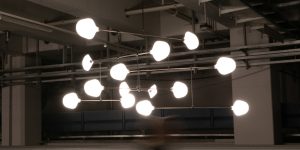
LeveL II
mischer'traxler studio (AT)
LeveL II – a further development of the LeveL – is the fragile balance of perfect system installation.

30°
Mathias Foot (DE), Franziska Rast (DE), Stephan Schakulat (DE)
Covering 71% of the Earth’s surface, water is an important part of the global ecosystem. Every development and change in the sea also affect life on earth. Datasets help us to understand conditions and ecological processes such as changes in salinity or temperature. 30° is a data visualization of marine data in the form of an installation.

In Rhythmic fragments
Saria Ghaziri (FR/LB), Dalia Todary-Michael (CA/EG)
In Rhythmic Fragments is a biophilic spatial installation that translates mensurated motions into kinetic architectural boundaries. Inspired by the rhythmic flows of energy observed at varied scales in the natural environment, the installation aims to engage our mind with contemplative content to evoke the sense of being mesmerized.


